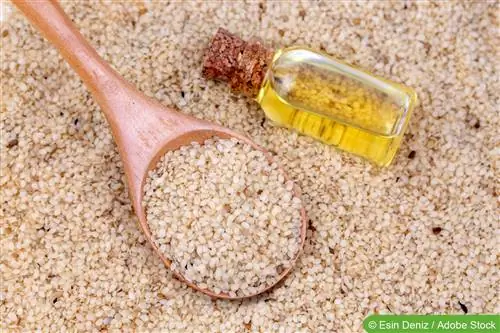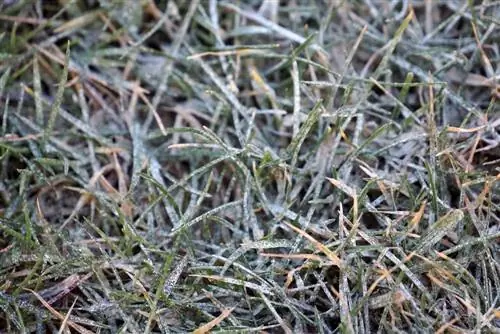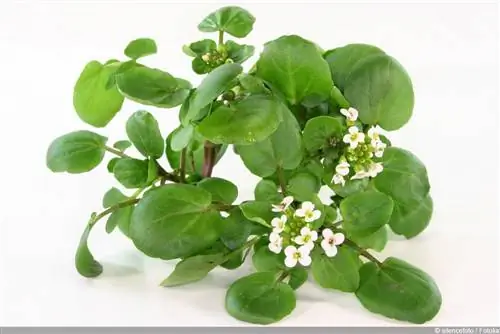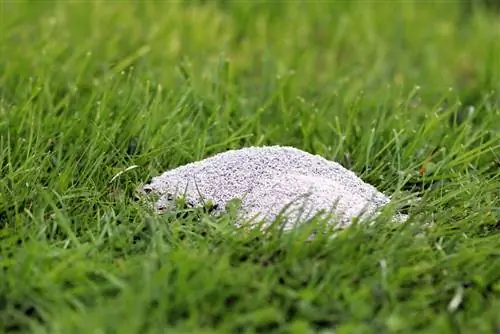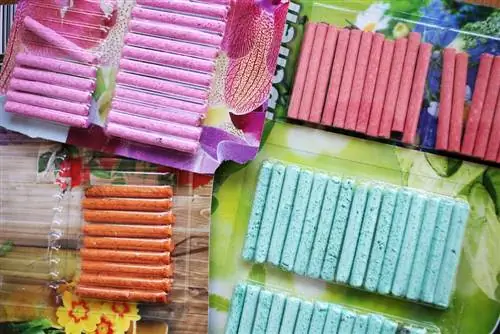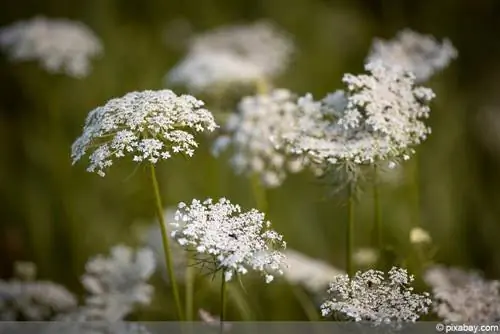- Author admin [email protected].
- Public 2023-12-17 03:39.
- Last modified 2025-01-24 12:45.
Sesame has been cultivated on a large scale for thousands of years, but it is still rarely found in temperate climates. It is certainly possible to successfully grow Sesamum indicum here and harvest it in your own garden. In order for the heat-loving plant to thrive in time, there are a few special features that need to be taken into account. However, if you pay attention to the requirements of sesame, you can achieve a large yield even with little cultivation area. And until then, enjoy the exotic beauty of the plant.
Location
The annual sesame needs a warm and full sun location that is not too close to water or in otherwise damp corners. However, a lot of space is not necessary for the sesame plants. Although Sesamum indicum can reach a height of one to one and a half meters, it grows very slenderly. Therefore, a distance of 30 to 50 cm between the plants is sufficient. Cultivation in small areas or cultivation in pots is therefore possible without any problems. In regions with rather cool and humid summers, container culture actually makes sense. On the one hand, the sesame can only tolerate prolonged moisture to a limited extent and on the other hand, it should be kept at 20 °C or better even warmer.
Tip:
Sesame grows better in front of walls or in corners where the heat accumulates in summer. Greenhouses and winter gardens are also suitable.
Substrate
Sesame needs a nutrient-rich and permeable substrate to thrive. It does best with a neutral pH value. Fresh garden soil enriched with rotted leaves and compost is a good base. High-quality potting soil is also suitable. Sand should be added to the substrate to loosen it up and improve permeability. Coconut fiber is also useful as an addition. In addition to the substrate, a drainage layer should be placed at the bottom of the container.
cultivation
Sesame seeds require a temperature of 20 °C to 25 °C and sufficient brightness to germinate. In addition, it takes around 120 days from the first shoots to flowering and the fruiting bodies ripening. The Sesamum indicum also needs to spend this time warm. In temperate climates, this is hardly possible outdoors. Growing seeds indoors is therefore not only advisable, but also essential for a successful harvest. It's best to start in February or March. The following steps must be observed:
- Mix the substrate described above, place the seeds on top and cover with about 1 cm of soil.
- Wet the substrate but do not soak it.
- Cover the container with glass or foil and place it in a bright place where the temperature is at least 20 °C.
- The cover should be ventilated briefly every day and the substrate should be kept moist at all times.
- The seeds should germinate after about two weeks. When the time comes, the cover can be removed. However, the earth should not dry out.
The young plants can leave the house if the temperature outside is at least 20 °C. Then the time has come to use it in a bucket or the bed.
Cultivation

If the outside temperatures have consistently reached at least 20 °C, sesame cultivation can be started outdoors. To do this, the young plants are placed individually in the soil at a distance of 30 cm to 50 cm. When moving from the pre-growing pots, you must be very careful, the roots are sensitive and must not be injured. In cool summers or regions with cold winds and otherwise low temperatures, sesame seeds should be grown in containers. This allows the plants to soak up the sun during the day and be fertilized by insects during flowering. However, when the temperature drops, they are easy to bring into the house. After planting in the bed, the maintenance effort is reduced significantly. Only at harvest time does some effort have to be put in again.
Pouring
During germination and as long as the Sesamum indicum is in the initial cultivation containers, it needs a constantly moist substrate. If it has been moved to a bed or a bucket and has grown here, watering can be significantly reduced. Sesame copes well with drought, even if it lasts longer. Additional watering is only necessary if the leaves begin to droop or to prevent the substrate in the container from drying out completely. However, rainfall is usually enough.
Fertilize
If sesame cultivation begins in fresh, nutrient-rich soil, further fertilization is hardly necessary. A little organic fertilizer when moving the young plants doesn't hurt either. Compost or coffee grounds mixed into the soil can stimulate growth. Pond water without chemical additives or nettle manure is suitable as an addition to irrigation water. But it doesn't have to be exaggerated. Small amounts are completely sufficient.
Harvesting the Seeds
From the moment it blooms, sesame development occurs comparatively quickly. The flowers produce oval-shaped fruiting bodies that turn brownish over time. If they are brown all over and start to open, it is time to harvest. You have to do this quickly before the Sesamum indicum seeds are dispersed by the wind. So that they don't fall out of the pods during harvest, a small bag should be pulled over the pods from below. Only then is the fruiting body cut off and dropped into the bag. The sesame should then be air dried. Packed back into the bag, the seeds can be separated from their shell by spinning and gently hitting them on a hard surface.
Blend
Blending is not necessary with Sesamum indicum.
Wintering
Since the sesame plant is an annual plant, overwintering is not necessary.
Usage
The seeds can be roasted, used in baking or pressed for the oil they contain. In addition to the well-known seeds, sesame leaves can also be used in the kitchen. Harvested fresh and green, they are suitable for grilling, cooking and pickling.
Typical diseases, pests and care errors
Sesame is hardly affected by diseases and pests. However, soil that is too wet can lead to rot. Above all, correct watering and a permeable substrate are crucial.
Frequently asked questions
Why does sesame grow so slowly?
The sesame grows very slowly until it flowers, only then does it show strong shoots. Under optimal conditions, slow growth is no reason to worry.
Where do I get sesame seeds from?
Sesamum indicum Seeds are not always easy to find, although they can increasingly be found in seed stores with exotic sections. Alternatively, the seeds are also available in Asian supermarkets.
What you should know about sesame in brief
Sesame is one of the oldest oil plants in the world. It originally comes from India and Africa. Today sesame is grown throughout tropical and subtropical regions. The oil and grains of the plant are used.
Profile
- Sesame is an annual, herbaceous plant.
- It can grow from 10 to 120 cm high, rarely even higher.
- Today's cultivated sesame comes from a wild species from South Asia.
- There is a distinction between black and white sesame.
- Black sesame has a slightly more intense taste.
- The taste itself is slightly nutty, which is enhanced by roasting.
- China and India are leaders in sesame production.
- Sesame oil has a favorable composition of monounsaturated and polyunsaturated fats.
- Sesamol and sesamolin contained in the oil act as strong antioxidants, rendering oxygen radicals harmless.
- Sesame oil should be stored in dark bottles. It will last for about a year in the refrigerator.
Usage
- Seeds, oil and roots of the sesame plant are used. They are used for therapeutic and culinary purposes.
- You should use high quality products!
- Sesame oil, which is obtained from the seeds, is well known. It is used for cooking. It is pressed from the roasted seeds.
- Cold-pressed oils must only be heated carefully, otherwise the aromas will decompose. These oils are suitable for salads or for dishes cooked at low temperatures.
- Hot pressed sesame oil needs to be refined! It is often used in the western world to make margarine.
- The seeds themselves refine baked goods or you can also season them.
- Sesame is an allergen. It must always be stated on the ingredient list for processed foods!
- Sesame paste is mainly used in Arabic cuisine.
- Sesame oil is an integral part of Asian cuisine.
- In Mexico, sesame is an ingredient in the famous Mole Poblano, a seasoning paste with lots of spices and chocolate.
- Everyone knows sesame seeds on rolls and bread.
- Sesame oil contains components that ward off fungi, bacteria and viruses. The lecithin it also contains is important for the functionality of the nerve cells.
- Sesame seeds should be toasted in a dry pan before use until a nutty scent appears.
- Cold-pressed sesame oil is often used in natural cosmetics. E.g. as a massage oil and for skin care.
Conclusion
Sesame has many uses. The taste is unique and immediately recognizable. Sesame seeds should be used roasted. When it comes to oils, cold-pressed oil is recommended. The ingredients are he alth-promoting and good for the skin. In the kitchen, sesame impresses with its nutty taste. Sesame, an interesting plant with versatile uses.
Image source: Gustav Pabst (ed.): Köhler’s medicinal plants in lifelike illustrations with a short explanatory text. Gera 1887.

